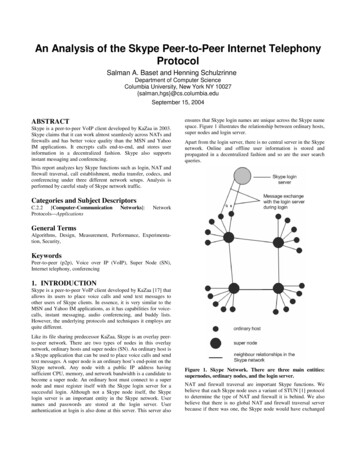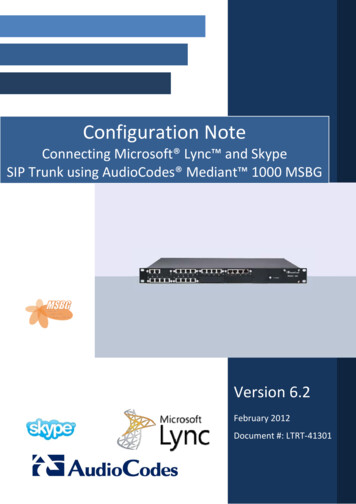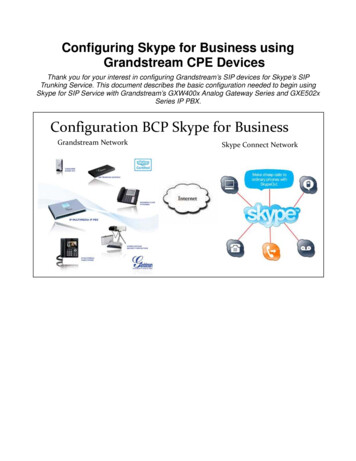
Transcription
An Analysis of the Skype Peer-to-Peer Internet TelephonyProtocolSalman A. Baset and Henning SchulzrinneDepartment of Computer ScienceColumbia University, New York NY 10027{salman,hgs}@cs.columbia.eduSeptember 15, 2004ABSTRACTSkype is a peer-to-peer VoIP client developed by KaZaa in 2003.Skype claims that it can work almost seamlessly across NATs andfirewalls and has better voice quality than the MSN and YahooIM applications. It encrypts calls end-to-end, and stores userinformation in a decentralized fashion. Skype also supportsinstant messaging and conferencing.ensures that Skype login names are unique across the Skype namespace. Figure 1 illustrates the relationship between ordinary hosts,super nodes and login server.Apart from the login server, there is no central server in the Skypenetwork. Online and offline user information is stored andpropagated in a decentralized fashion and so are the user searchqueries.This report analyzes key Skype functions such as login, NAT andfirewall traversal, call establishment, media transfer, codecs, andconferencing under three different network setups. Analysis isperformed by careful study of Skype network traffic.Categories and Subject �ApplicationsNetworks]:NetworkGeneral TermsAlgorithms, Design, Measurement, Performance, Experimentation, Security,KeywordsPeer-to-peer (p2p), Voice over IP (VoIP), Super Node (SN),Internet telephony, conferencing1. INTRODUCTIONSkype is a peer-to-peer VoIP client developed by KaZaa [17] thatallows its users to place voice calls and send text messages toother users of Skype clients. In essence, it is very similar to theMSN and Yahoo IM applications, as it has capabilities for voicecalls, instant messaging, audio conferencing, and buddy lists.However, the underlying protocols and techniques it employs arequite different.Like its file sharing predecessor KaZaa, Skype is an overlay peerto-peer network. There are two types of nodes in this overlaynetwork, ordinary hosts and super nodes (SN). An ordinary host isa Skype application that can be used to place voice calls and sendtext messages. A super node is an ordinary host’s end-point on theSkype network. Any node with a public IP address havingsufficient CPU, memory, and network bandwidth is a candidate tobecome a super node. An ordinary host must connect to a supernode and must register itself with the Skype login server for asuccessful login. Although not a Skype node itself, the Skypelogin server is an important entity in the Skype network. Usernames and passwords are stored at the login server. Userauthentication at login is also done at this server. This server alsoFigure 1. Skype Network. There are three main entities:supernodes, ordinary nodes, and the login server.NAT and firewall traversal are important Skype functions. Webelieve that each Skype node uses a variant of STUN [1] protocolto determine the type of NAT and firewall it is behind. We alsobelieve that there is no global NAT and firewall traversal serverbecause if there was one, the Skype node would have exchanged
traffic with it during login and call establishment in the manyexperiments we performed.2.3 CodecsThe Skype network is an overlay network and thus each Skypeclient (SC) should build and refresh a table of reachable nodes. InSkype, this table is called host cache (HC) and it contains IPaddress and port number of super nodes. It is stored in theWindows registry for each Skype node.The white paper [7] observes that Skype uses iLBC [8], iSAC [9],or a third unknown codec. GlobalIPSound [10] has implementedthe iLBC and iSAC codecs and their website lists Skype as theirpartner. We believe that Skype uses their codec implementations.We measured that the Skype codecs allow frequencies between50-8,000 Hz to pass through. This frequency range is thecharacteristic of a wideband codec.Skype claims to have implemented a ‘3G P2P’ or ‘Global Index’[2] technology (Section 4.3), which is guaranteed to find a user ifthat user has logged in the Skype network in the last 72 hours.2.4 Buddy ListSkype uses wideband codecs which allows it to maintainreasonable call quality at an available bandwidth of 32 kb/s. Ituses TCP for signaling, and both UDP and TCP for transportingmedia traffic. Signaling and media traffic are not sent on the sameports.Skype stores its buddy information in the Windows registry.Buddy list is digitally signed and encrypted. The buddy list islocal to one machine and is not stored on a central server. If a useruses SC on a different machine to log onto the Skype network,that user has to reconstruct the buddy list.2.5 EncryptionThe rest of this report is organized as follows. Section 2 describeskey components of the Skype software and the Skype network.Section 3 describes the experimental setup. Section 4 discusseskey Skype functions like startup, login, user search, callestablishment, media transfer and codecs, and presence timers.Flow diagrams based on actual network traffic are used toelaborate on the details. Section 5 discusses conferencing. Section6 discusses other experiments.The Skype website [13] explains: “Skype uses AES (AdvancedEncryption Standard) – also known as Rijndel – which is alsoused by U.S. Government organizations to protect sensitiveinformation. Skype uses 256-bit encryption, which has a total of1.1 x 1077 possible keys, in order to actively encrypt the data ineach Skype call or instant message. Skype uses 1536 to 2048 bitRSA to negotiate symmetric AES keys. User public keys arecertified by Skype server at login.”2. KEY COMPONENTS OF THE SKYPESOFTWARE2.6 NAT and FirewallA Skype client listens on particular ports for incoming calls,maintains a table of other Skype nodes called host cache, useswideband codecs, maintains a buddy list, encrypts messages endto-end, and determines if it is behind a NAT or a firewall. Thissection discusses these components and functionalities in detail.2.1 PortsA Skype client (SC) opens a TCP and a UDP listening port at theport number configured in its connection dialog box. SCrandomly chooses the port number upon installation. In addition,SC also opens TCP listening ports at port number 80 (HTTPport), and port number 443 (HTTPS port). Unlike many Internetprotocols, like SIP [5] and HTTP [6], there is no default TCP orUDP listening port. Figure 15 shows a snapshot of the Skypeconnection dialog box. This figure shows the ports on which a SClistens for incoming connections.2.2 Host CacheThe host cache (HC) is a list of super node IP address and portpairs that SC builds and refreshes regularly. It is the most criticalpart to the Skype operation. At least one valid entry must bepresent in the HC. A valid entry is an IP address and port numberof an online Skype node. A SC stores host cache in the Windowsregistry at HKEY CURRENT USER / SOFTWARE / SKYPE /PHONE / LIB / CONNECTION / HOSTCACHE. After running aSC for two days, we observed that HC contained a maximum of200 entries. Host and peer caches are not new to Skype. Chord[19], another peer-to-peer protocol has a finger table, which ituses to quickly find a node.We conjecture that SC uses a variation of the STUN [1] andTURN [18] protocols to determine the type of NAT and firewall itis behind. We also conjecture that SC refreshes this informationperiodically. This information is also stored in the Windowsregistry.Unlike its file sharing counter part KaZaa, a SC cannot preventitself from becoming a super node.3. EXPERIMENTAL SETUPAll experiments were performed for Skype version 0.97.0.6.Skype was installed on two Windows 2000 machines. Onemachine was a Pentium II 200MHz with 128 MB RAM, and theother machine was a Pentium Pro 200 MHz with 128 MB RAM.Each machine had a 10/100 Mb/s Ethernet card and wasconnected to a 100 Mb/s network.We performed experiments under three different network setups.In the first setup, both Skype users were on machines with publicIP addresses; in the second setup, one Skype user was behindport-restricted NAT; in the third setup, both Skype users werebehind a port-restricted NAT and UDP-restricted firewall. NATand firewall machines ran Red Hat Linux 8.0 and were connectedto 100 Mb/s Ethernet network.Ethereal [3] and NetPeeker [4] were used to monitor and controlnetwork traffic, respectively. NetPeeker was used to tune thebandwidth so as to analyze the Skype operation under networkcongestion.For each experiment, the Windows registry was cleared of anySkype entries and Skype was reinstalled on the machine.All experiments were performed between February and April,2004.
4. SKYPE FUNCTIONSSkype functions can be classified into startup, login, user search,call establishment and tear down, media transfer, and presencemessages. This section discusses each of them in detail.4.1 StartupWhen SC was run for the first time after installation, it sent aHTTP 1.1 GET request to the Skype server (skype.com). The firstline of this request contains the keyword ‘installed’.During subsequent startups, a SC only sent a HTTP 1.1 GETrequest to the Skype server (skype.com) to determine if a newversion is available. The first line of this request contains thekeyword ‘getlatestversion’.See the Appendix for complete messages.4.2 LoginLogin is perhaps the most critical function to the Skype operation.It is during this process a SC authenticates its user name andpassword with the login server, advertises its presence to otherpeers and its buddies, determines the type of NAT and firewall itis behind, and discovers online Skype nodes with public IPaddresses. We observed that these newly discovered nodes wereused to maintain connection with the Skype network should theSN to which SC was connected became unavailable.4.2.1 Login ProcessAs discussed in Section 2, the HC must contain a valid entry for aSC to be able to connect to the Skype network. If the HC wasfilled with only one invalid entry, SC could not connect to theSkype network and reported a login failure. However, we gaineduseful insights in the Skype login process by observing themessage flow between SC and this invalid HC entry. Theexperimental setup and observations for the login process aredescribed below.First, we flushed the SC host cache and filled it with only oneentry which was the IP address and port number of a machine onwhich no Skype client was running. The SC was then started anda login attempt was made. Since HC had an invalid entry, SCcould not connect to the Skype network. We observed that the SCfirst sent a UDP packet to this entry. If there was no response afterroughly five seconds, SC tried to establish a TCP connection withthis entry. It then tried to establish a TCP connection to the HC IPaddress and port 80 (HTTP port). If still unsuccessful, it tried toconnect to HC IP address and port 443 (HTTPS port). SC thenwaited for roughly 6 seconds. It repeated the whole process fourmore times after which it reported a login failure.We observed that a SC must establish a TCP connection with aSN in order to connect to the Skype network. If it cannot connectto a super node, it will report a login failure.Most firewalls are configured to allow outgoing TCP traffic toport 80 (HTTP port) and port 443 (HTTPS port). A SC behind afirewall, which blocks UDP traffic and permits selective TCPtraffic, takes advantage of this fact. At login, it establishes a TCPconnection with another Skype node with a public IP address andport 80 or port 443.Figure 2. Skype login algorithm. Only one entry is present in theHC. If there is more than one entry, SC sends UDP packets tothem before attempting a TCP connection. Authentication withthe login server is not shown.4.2.2 Login ServerAfter a SC is connected to a SN, the SC must authenticate the username and password with the Skype login server. The login serveris the only central component in the Skype network. It storesSkype user names and passwords and ensures that Skype usernames are unique across the Skype name space. SC must
authenticate itself with login server for a successful login. Duringour experiments we observed that SC always exchanged data overTCP with a node whose IP address was 80.160.91.11. We believethat this node is the login server. A reverse lookup of this IPaddress retrieved NS records whose values are ns14.inet.tele.dkand ns15.inet.tele.dk. It thus appears from the reverse lookup thatthe login server is hosted by an ISP based in Denmark.connection with the login server, exchanges authenticationinformation with it, and finally closes the TCP connection. Theinitial TCP data exchange with the bootstrap SN and the loginserver shows the existence of a challenge-response mechanism.The TCP connection with the SN persisted as long as SN wasalive. When the SN became unavailable, SC establishes a TCPconnection with another SN.4.2.3 Bootstrap Super NodesAfter logging in for the first time after installation, HC wasinitialized with seven IP address and port pairs. We observed thatupon first login, HC was always initialized with these seven IPaddress and port pairs except for a rare random occurrence. In thecase where HC was initialized with more than seven IP addressesand port pairs, it always contained those seven IP address and portpairs. It was with one of these IP address and port entries a SCestablished a TCP connection when a user used that SC to logonto the Skype network for the first time after installation. We callthese IP address and port pairs bootstrap super nodes. Figure 16shows a snapshot of the host cache of the SC that contains IPaddress and port numbers of these bootstrap super nodes. TheseIP address and port pairs and their corresponding host namesobtained using a reverse lookup are:IP 3364.246.49.61:3303364.246.48.23:33033Reverse lookup trs-64-246-49-61.ev1.netns2.ev1.netFrom the reverse lookup, it appears that bootstrap SNs areconnected to the Internet through four ISPs. Superb [14], Suscom[15], ev1.net [16] are US-based ISPs.After installation and first time startup, we observed that the HCwas empty. However upon first login, the SC sent UDP packets toat least four nodes in the bootstrap node list. Thus, eitherbootstrap IP address and port information is hard coded in the SC,or it is encrypted and not directly visible in the Skype Windowsregistry, or this is a one-time process to contact bootstrap nodes.We also observed that if the HC was flushed after the first login,SC was unable to connect to the Skype network. Theseobservations suggest that we perform separate experiments toanalyze the first-time and subsequent login processes.4.2.4 First-time Login ProcessThe SC host cache was empty upon installation. Thus, a SC mustconnect to well known Skype nodes in order to log on to theSkype network. It does so by sending UDP packets to somebootstrap super nodes and then waits for their response over UDPfor some time. It is not clear how SC selects among bootstrap SNsto send UDP packets to. SC then established a TCP connectionwith the bootstrap super node that responded. Since more thanone node could respond, a SC could establish a TCP connectionwith more than one bootstrap node. A SC, however, maintains aTCP connection with at least one bootstrap node and may closeTCP connections with other nodes. After exchanging somepackets with SN over TCP, it then perhaps acquired the address ofthe login server (80.160.91.11). SC then establishes a TCPFigure 3. Message flow for the first login after installation forSC on a public IP address. ‘B’ stands for bytes and ‘N’ stands
for node. SYN and ACK packets are shown to indicate whoinitiated TCP connection. Message flows are not strictlyaccording to time. Messages have been grouped together toprovide a better picture. Message size corresponds to size ofTCP or UDP payload. Not all messages are shown.For the login process, we observed message flow for the sameSkype user id for the three different network setups described inSection 3.The message flow for the first-time login process for a SC runningon a machine with public IP address is shown in Figure 3. Thetotal data exchanged between SC, SN, login server, and othernodes during login is about 9 kilobytes.Figure 4. Message flow for first login after installation for SCbehind a simple NAT. ‘B’ stands for bytes and ‘N’ stands fornode. SYN and ACK packets are shown to indicate whoinitiated TCP connection. Message flows are not strictlyaccording to time. Messages have been grouped together toprovide a better picture. Message size corresponds to size ofTCP or UDP payload. Not all messages are shown in themessage flow.For a SC behind a port-restricted NAT, the message flow for loginwas roughly the same as for a SC on a public IP address.However, more data was exchanged. On average, SC exchanged10 kilobytes of data with SN, login server, and other Skype nodes.The message flow is shown in Figure 4.A SC behind a port-restricted NAT and a UDP-restricted firewallwas unable to receive any UDP packets from machines outside thefirewall. It therefore could send and receive only TCP traffic. Ithad a TCP connection with a SN and the login server, and itexchanged information with them over TCP. On average, itexchanged 8.5 kilobytes of data with SN, login server, and otherSkype nodes. The message flow is shown in Figure 5.
The following inferences can be drawn by careful observation ofcall flows in Fig 3, 4, and 5.4.2.4.1 NAT and Firewall DeterminationWe conjecture that a SC is able to determine at login if it isbehind a NAT and firewall. We guess that there are at least twoways in which a SC can determine this information. Onepossibility is that it can determine this information by exchangingmessages with its SN using a variant of the STUN [1] protocol.The other possibility is that during login, a SC sends and possiblyreceives data from some nodes after it has made a TCP connectionwith the SN. We conjecture that at this point, SC uses its variationof STUN [1] protocol to determine the type of NAT or firewall itis behind. Once determined, the SC stores this information in theWindows registry. We also conjecture that SC refreshes thisinformation periodically. We are not clear on how often a SCrefreshes this information since Skype messages are encrypted.4.2.4.2 Alternate Node TableSkype is a p2p client and p2p networks are very dynamic. SC,therefore, must keep track of online nodes in the Skype networkso that it can connect to one of them if its SN becomesunavailable.From Figure 3 and 4, it can be seen that SC sends UDP packets to22 distinct nodes at the end of login process and possibly receivesa response from them if it is not behind a UDP-restricted firewall.We conjecture that SC uses those messages to advertise its arrivalon the network. We also conjecture that upon receiving a responsefrom them, SC builds a table of online nodes. We call this tablealternate node table. It is with these nodes a SC can connect to, ifits SN becomes unavailable. The subsequent exchange ofinformation with some of these nodes during call establishmentconfirms that such a table is maintained.It can be seen from Figure 3, 4, and 5, that SC sends ICMPmessages to some nodes in the Skype network. The reason forsending these messages is not clear.4.2.5 Subsequent Login ProcessThe subsequent login process was quite similar to the first-timelogin process. The SC built a HC after a user logged in for thefirst time after installation. The HC got periodically updated withthe IP address and port number of new peers. During subsequentlogins, SC used the login algorithm to determine at least oneavailable peer out of the nodes present in the HC. It thenestablished a TCP connection with that node. We also observedthat during subsequent logins, SC did not send any ICMP packets.4.2.6 Login Process TimeFigure 5. Message flow for first login after installation for aSC behind a firewall, which blocks UDP packets. ‘B’ standsfor bytes and ‘N’ stands for node. SYN and ACK packets areshown to indicate who initiated TCP connection. Messageflows are not strictly according to time. Messages have beengrouped together to provide a better picture. Message sizecorresponds to size of TCP or UDP payload. Not all messagesare shown in the message flow.We measured the time to login on the Skype network for the threedifferent network setups described in Section 3. For thisexperiment, the HC already contained the maximum of twohundred entries. The SC with a public IP address and the SCbehind a port-restricted NAT took about 3-7 seconds to completethe login procedures. The SC behind a UDP-restricted firewalltook about 34 seconds to complete the login process. For SCbehind a UDP-restricted firewall, we observed that it sent UDPpackets to its thirty HC entries. At that point it concluded that it isbehind UDP-restricted firewall. It then tried to establish a TCPconnection with the HC entries and was ultimately able to connectto a SN.
4.3 User SearchSkype uses its Global Index (GI) [2] technology to search for auser. Skype claims that search is distributed and is guaranteed tofind a user if it exists and has logged in during the last 72 hours.Extensive testing suggests that Skype was always able to locateusers who logged in using public or private IP address in the last72 hours.Skype is a not an open protocol and its messages are encrypted.Whereas in login we were able to form a reasonably preciseopinion about different entities involved, it is not possible to doso in search, since we cannot trace the Skype messages beyond aSN. Also, we were unable to force a SC to connect to a particularSN. Nevertheless, we have observed and present search messageflows for the three different network setups.6&7&37&3 8'38'38'38'3login process and responses were received from them. Messagesize corresponds to payload size of TCP or UDP packets.A SC behind a port-restricted NAT exchanged data between SN,and some of the nodes which responded to its UDP request duringlogin process. The message flow is shown in Figure 7.A SC behind a port-restricted NAT and UDP-restricted firewallsent the search request over TCP to its SN. We believe that SNthen performed the search query and informed SC of the searchresults. Unlike user search by SC on a public IP address, SC didnot contact any other nodes. This suggests that SC knew that itwas behind a UDP-restricted firewall. The message flow is shownFigure 8.61 % % % 1 % 1 % 1 % 1 Figure 6. Message flow for user search when SC has a publicIP address. ‘B’ stands for bytes and ‘N’ stands for node.Message sizes correspond to payload size of TCP or UDPpackets.A SC has a search dialog box. After entering the Skype user idand pressing the find button, SC starts its search for a particularuser. For SC on a public IP address, SC sent a TCP packet to itsSN. It appears that SN gave SC the IP address and port number offour nodes to query, since after that exchange with SN, SC sentUDP packets to four nodes. We also observed that SC had notexchanged any information with these four nodes during login.SC then sent UDP packets to those nodes. If it could not find theuser, it informed the SN over TCP. It appears that the SN nowasked it to contact eight different nodes, since SC then sent UDPpackets to eight different nodes. This process continued until theSC found the user or it determined that the user did not exist. Onaverage, SC contacted eight nodes. The search took three to fourseconds. We are not clear on how SC terminates the search if it isunable to find a user.Figure 8. User search by a SC behind a UDP-restrictedfirewall. ‘B’ stands for bytes. Data is exchanged with SN only.Message size corresponds to payload size of TCP/UDP packets.4.3.1 Search Result CachingTo observe if search results are cached at intermediate nodes, weperformed the following experiment. User A was behind a portrestricted NAT and UDP-restricted firewall, and he logged on theSkype network. User B logged in using SC running on machine B,which was on public IP address. User B (on public IP) searchedfor user A, who is behind port-restricted NAT and UDP-restrictedfirewall. We observed that search took about 6-8 seconds. Next,SC on machine B was uninstalled, and Skype registry cleared soas to remove any local caches. SC was reinstalled on machine Band user B searched for user A. The search took about 3-4seconds. This experiment was repeated four times on differentdays and similar results were obtained.From the above discussion we infer that the SC performs userinformation caching at intermediate nodes.4.4 Call Establishment and TeardownFigure 7. Message flow for user search when SC is behind aport-restricted NAT. ‘B’ stands for bytes and ‘N’ stands fornode. UDP packets were sent to N1, N2, N3, and N4 duringWe consider call establishment for the three network setupsdescribed in Section 3. Further, for each setup, we consider callestablishment for users that are in the buddy list of caller and for
users that are not present in the buddy list. It is important to notethat call signaling is always carried over TCP.For users that are not present in the buddy list, call placement isequal to user search plus call signaling. Thus, we discuss callestablishment for the case where callee is in the buddy list ofcaller.If both users were on public IP addresses, online and were in thebuddy list of each other, then upon pressing the call button, thecaller SC established a TCP connection with the callee SC.Signaling information was exchanged over TCP. The messageflow between caller and callee is shown in Figure 9.The initial exchange of messages between caller and calleeindicates the existence of a challenge-response mechanism. Thecaller also sent some messages (not shown in Figure 9) over UDPto alternate Skype nodes, which are online Skype nodesdiscovered during login. For this scenario, three kilobytes of datawas exchanged.&DOOHU SUHVV GLDO&DOOHU7&3 6 17&3 &.7&37&37&37&37&37&37&37&37&3&DOOHH % % % % % % % % %&DOOHH ULQJVFigure 9. Message flow for call establishment when caller andcallee SC are on machines with public IP addresses and calleeis present in the buddy lists of caller. ‘B’ stands for bytes. Notall messages are shown.In the second network setup, where the caller was behind portrestricted NAT and callee was on public IP address, signaling andmedia traffic did not flow directly between caller and callee.Instead, the caller sent signaling information over TCP to anonline Skype node which forwarded it to callee over TCP. Thisonline node also routed voice packets from caller to callee overUDP and vice versa. The message flow is shown in Figure 10.Figure 10. Message flow for call establishment when caller SCis behind a port-restricted NAT and callee SC is on public IPaddress. ‘B’ stands for bytes and ‘N’ stands for node. Not allmessages are shown. Caller SC sent UDP messages to nodes 5,6, 7, and 8 during login and received responses from them. Wethus believe caller SC stored the IP address and port of thesenodes in its internal tables, which we call the alternate nodetable.For the third setup, in which both users were behind portrestricted NAT and UDP-restricted firewall, both caller and calleeSC exchanged signaling information over TCP with anotheronline Skype node. Caller SC sent media over TCP to an onlinenode, which forwarded it to callee SC over TCP and vice versa.The message flow is shown in Figure 11.
generally do not want that arbitrary traffic should flow across theirmachines.During call tear-down, signaling information is exchanged overTCP between caller and callee if they are both on public IPaddresses, or between caller, callee and their respective SNs. Themessages observed for call tear down between caller and callee onpublic IP addresses are shown in Figure 12.Figure 12. Call tear down message flow for caller and calleewith public IP addressesFor the second, and third network setups, call tear down signalingis also sent over TCP. We, however, do not present these messageflows, as they do not provide any interesting information.4.5 Media Transfer and CodecsIf both Skype clients are on public IP address, then media trafficflowed directly between them over UDP. The media traffic flowedto and from the UDP port configured in the options dialog box.The size of voice packet was 67 bytes, which is the size of UDPpayload. For two users connected to Internet over 100 Mb/sEthernet with almost no congestion in the network, roughly 140voice packets were exchanged both ways in one second. Thus, thetotal uplink and downlink bandwidth used for voice traffic is 5kilobytes/s. This bandwidth usage corresponds with the Skypeclaim of 3-16 kilobytes/s.If either caller or callee or both were behind port-restricted NAT,they sent voice traffic to another online Skype node over UDP.That node acted as a media proxy and forwarded the voice trafficfrom caller to callee and vice versa. The voice packet size was 67bytes, which is the size of UDP payload. The bandwidth used was5 kilobytes/s.If both users were behind port-restricted NAT and UDP-restrictedfirewall, then caller and callee sent and received voice traffic overTCP from another online Skype node. The TCP packet payloadsize for voice traffic was 69 bytes. The total uplink and downlinkbandwidth used for voice traffic is about 5 kilobytes/s. For mediatraffic, SC used TCP with retransmissions.The Skype protocol seems to prefer the use of UDP for voicetransmission as much as possible. The SC will use UDP for voicetransmission if it is behind a NAT or firewall that allows UDPpackets to flow across.Figure 11. Message flow for call establishment when caller andcallee SC are behind a port-restricted NAT and UDPrestricted firewall. ‘B’ stands for bytes and ‘N’ stands for anode.
Skype is a peer-to-peer VoIP client developed by KaZaa in 2003. Skype claims that it can work almost seamlessly across NATs and firewalls and has better voice quality than the MSN and Yahoo IM applications. It encrypts calls end-to-end, and stores user information in a decentralized fashion. Skype also supports instant messaging and conferencing.










